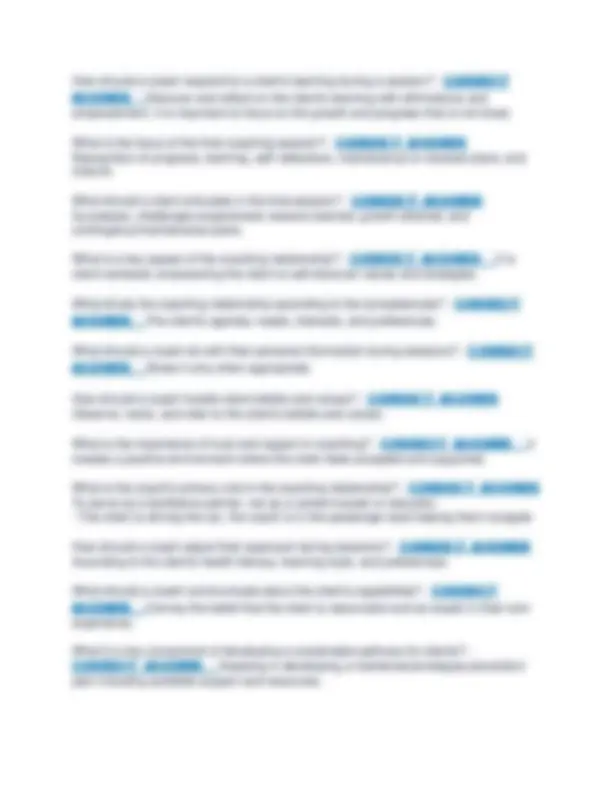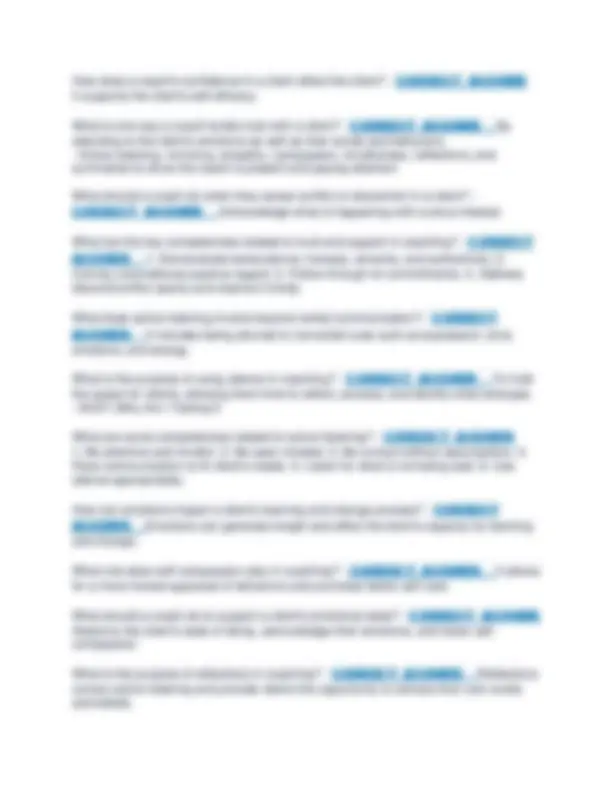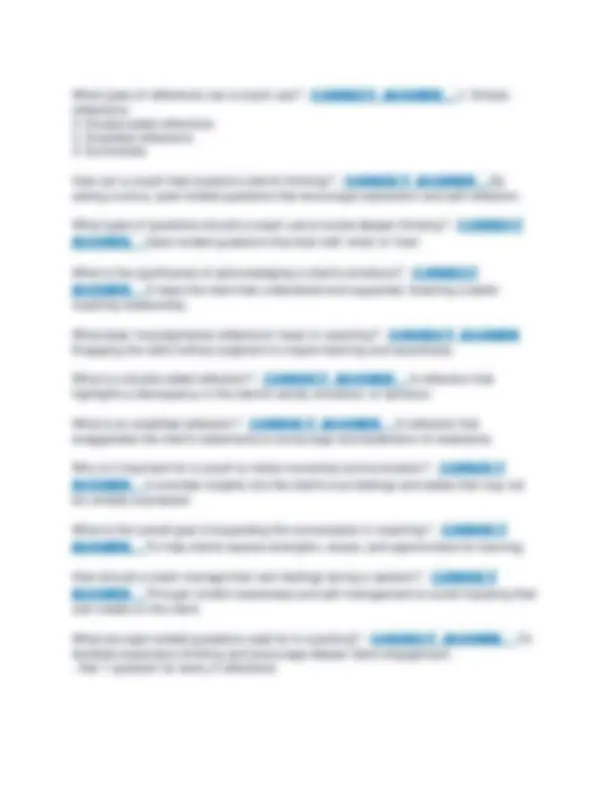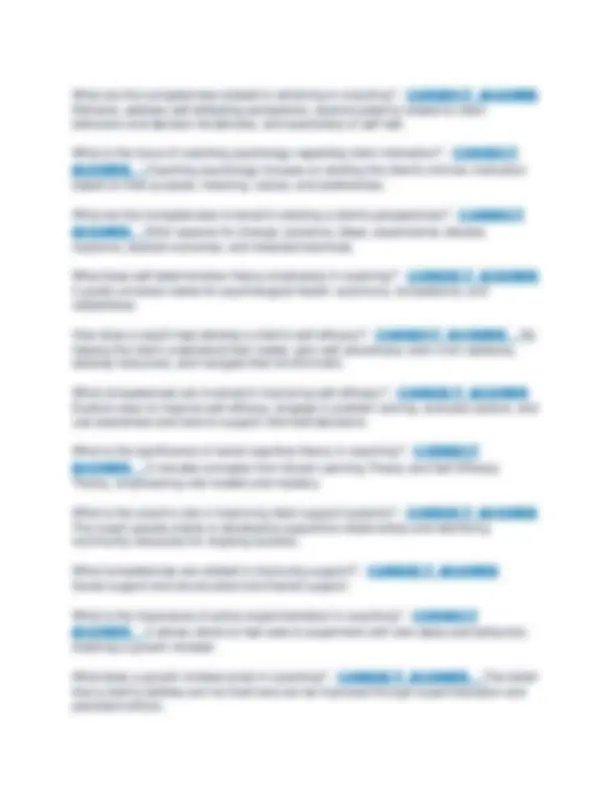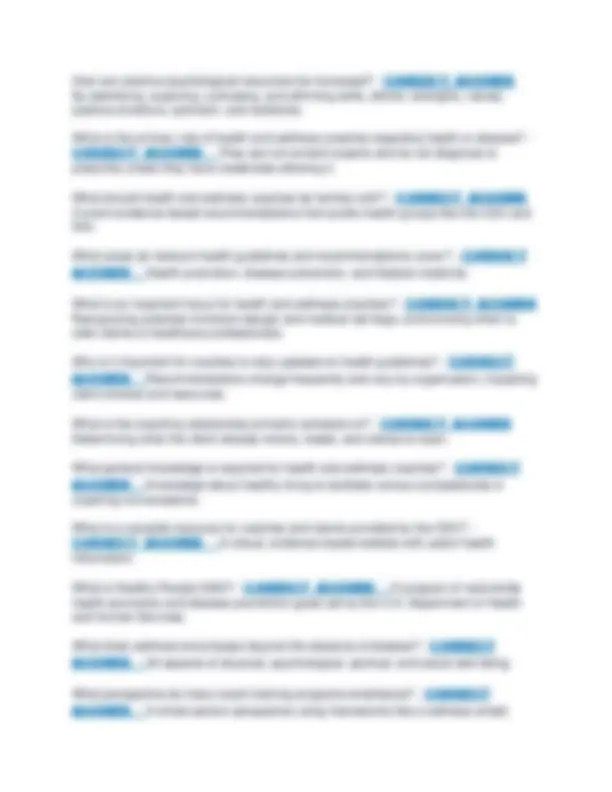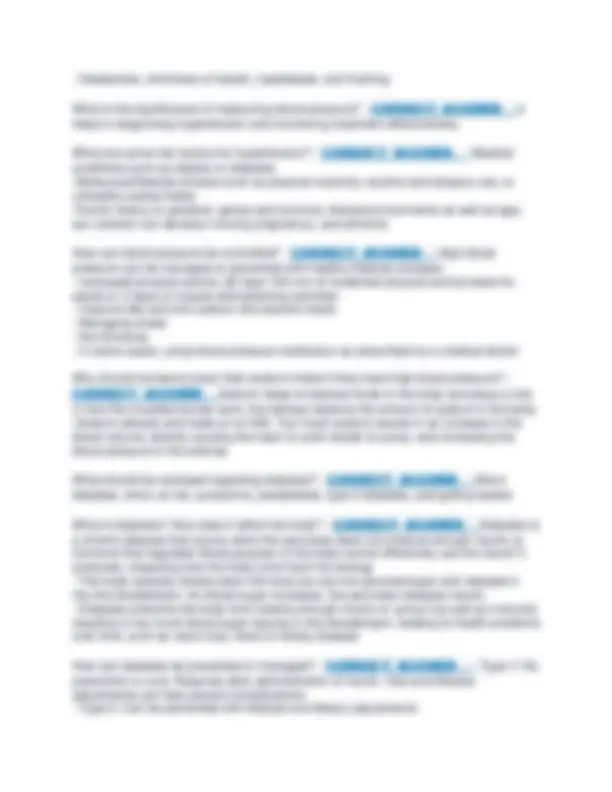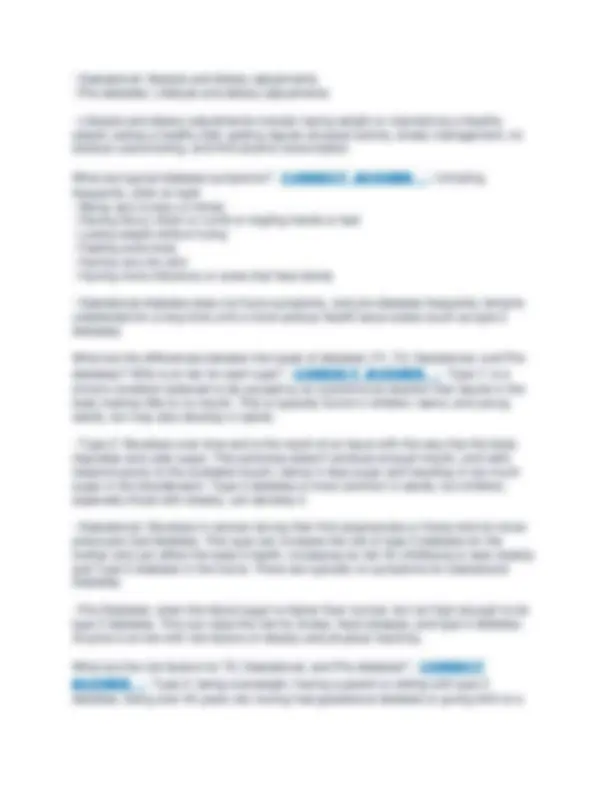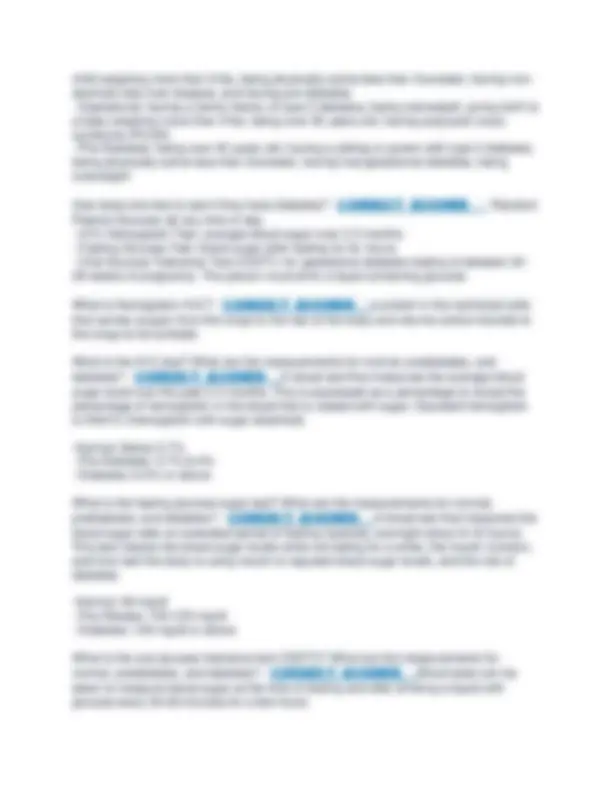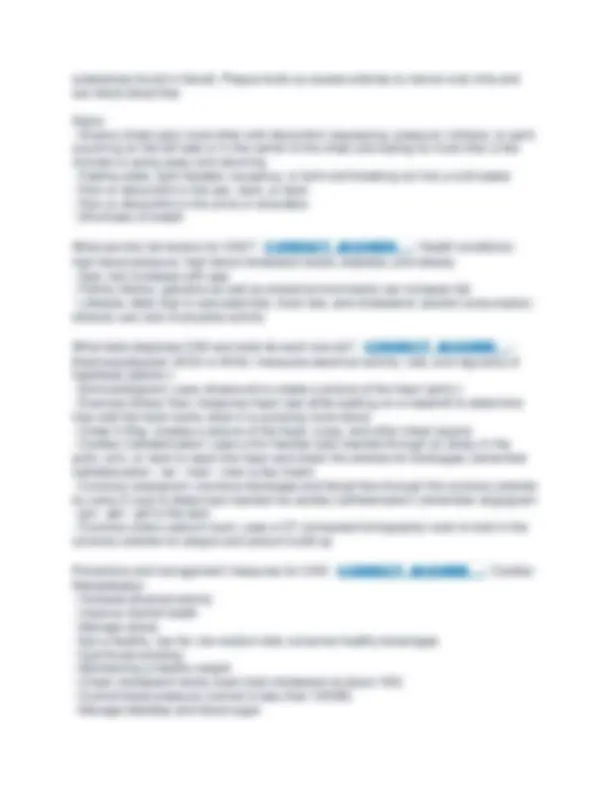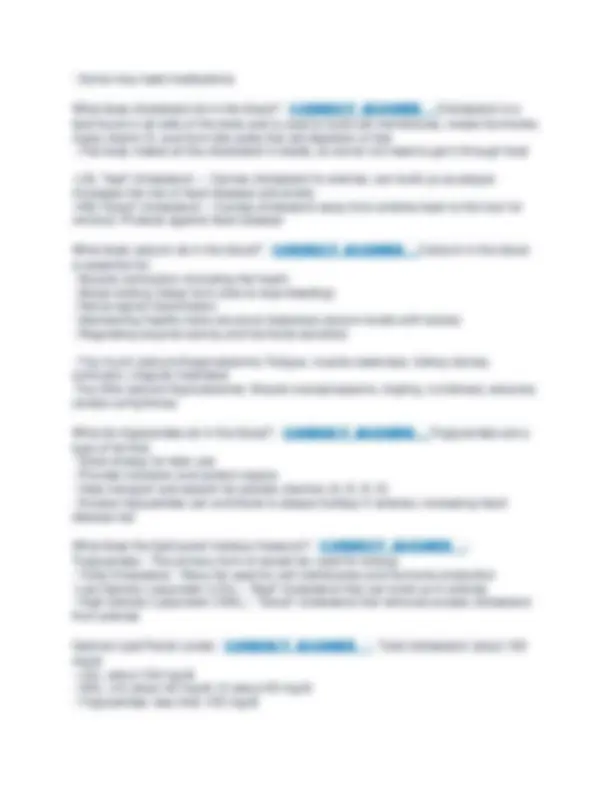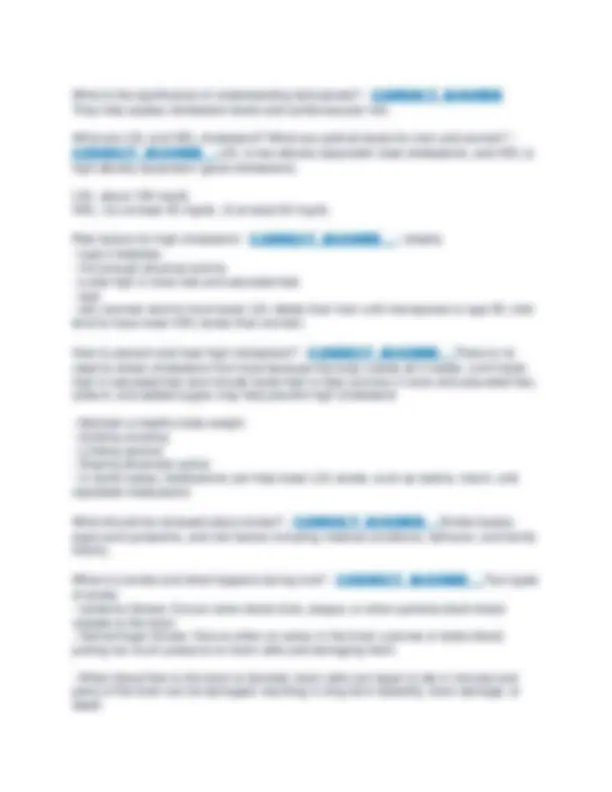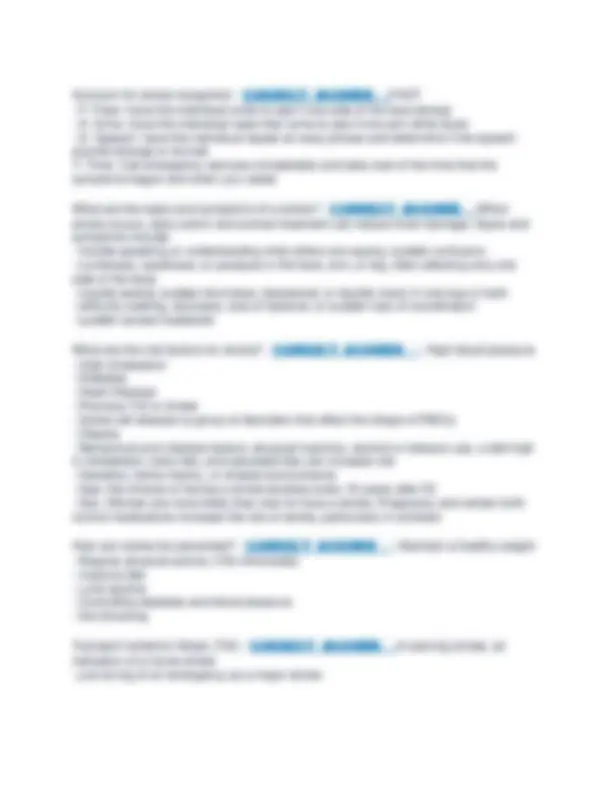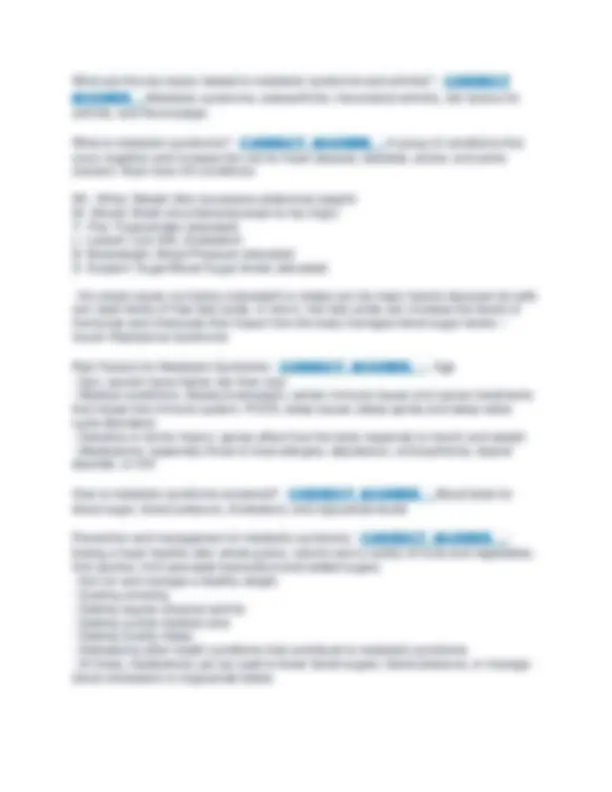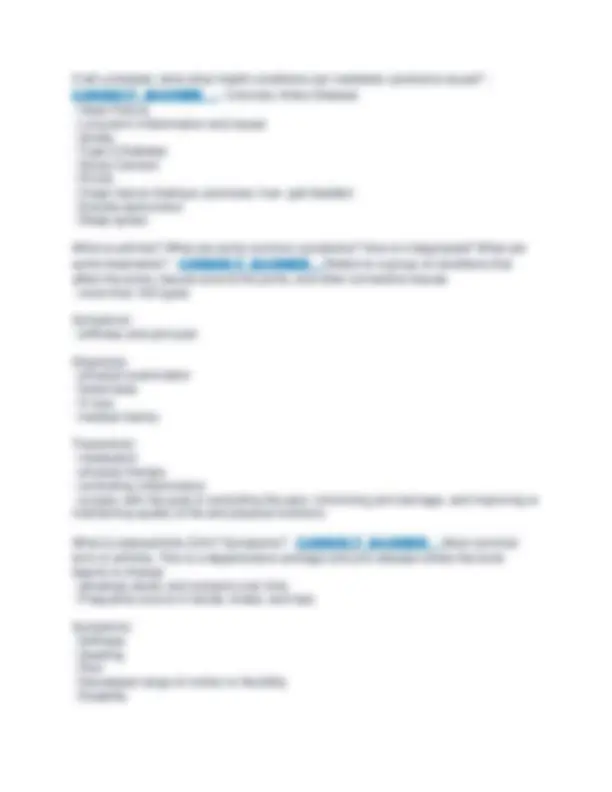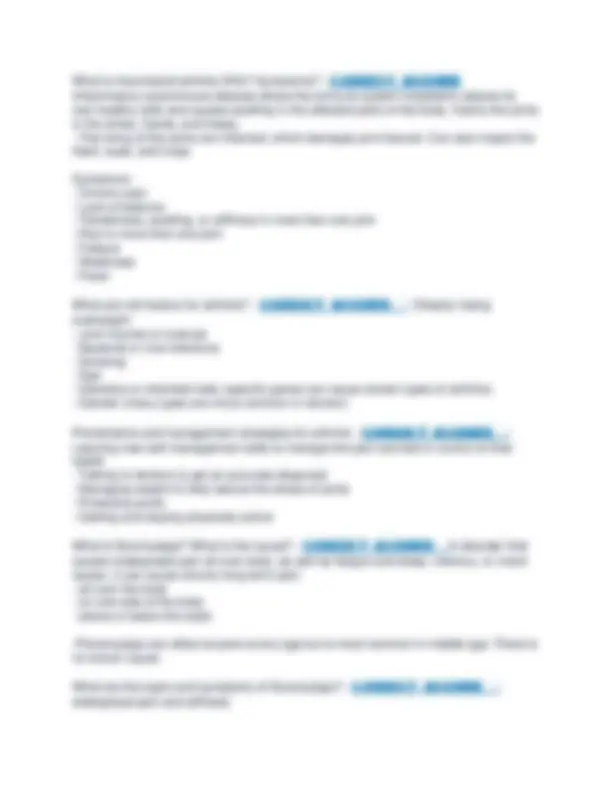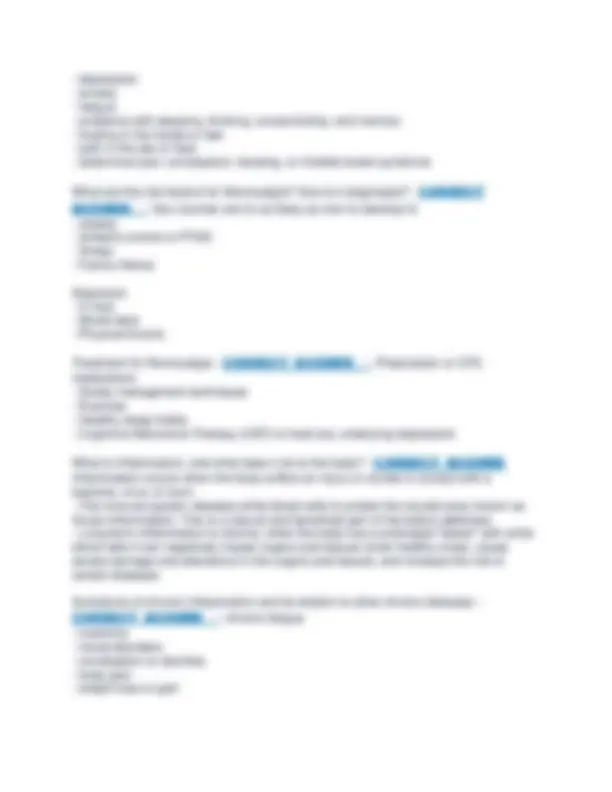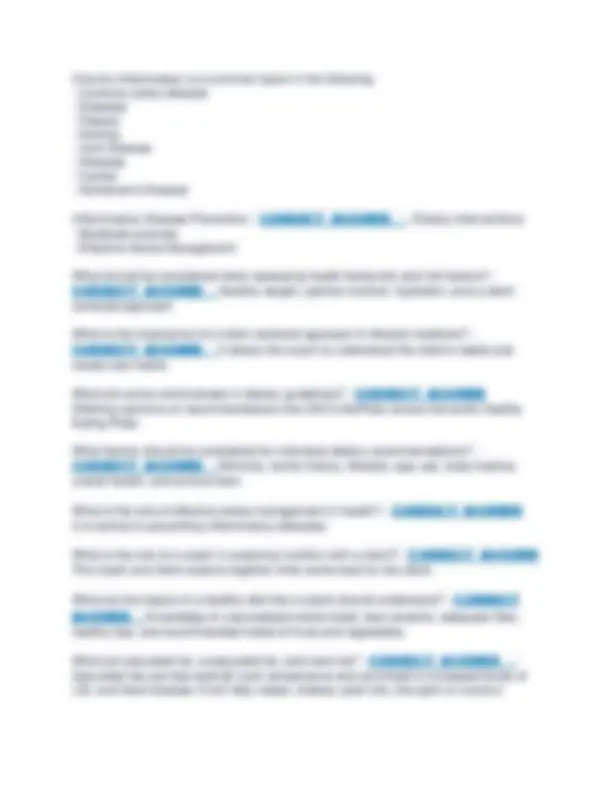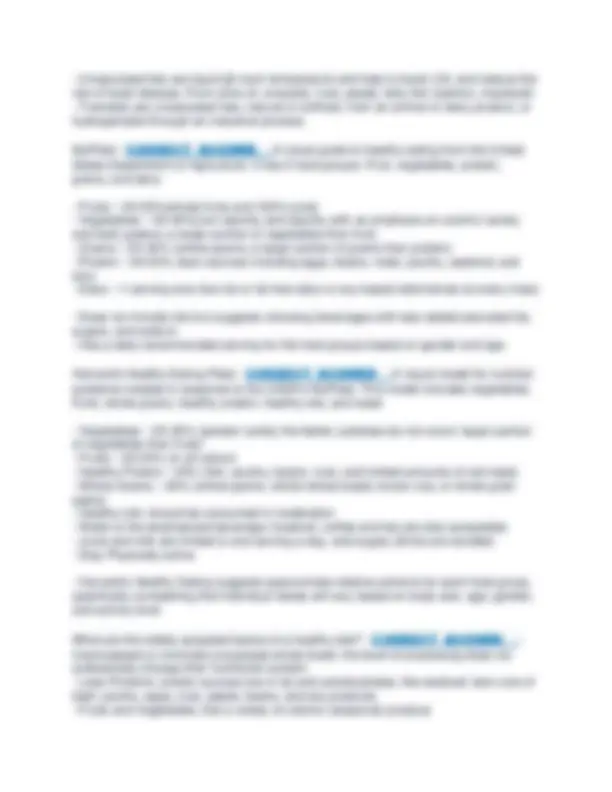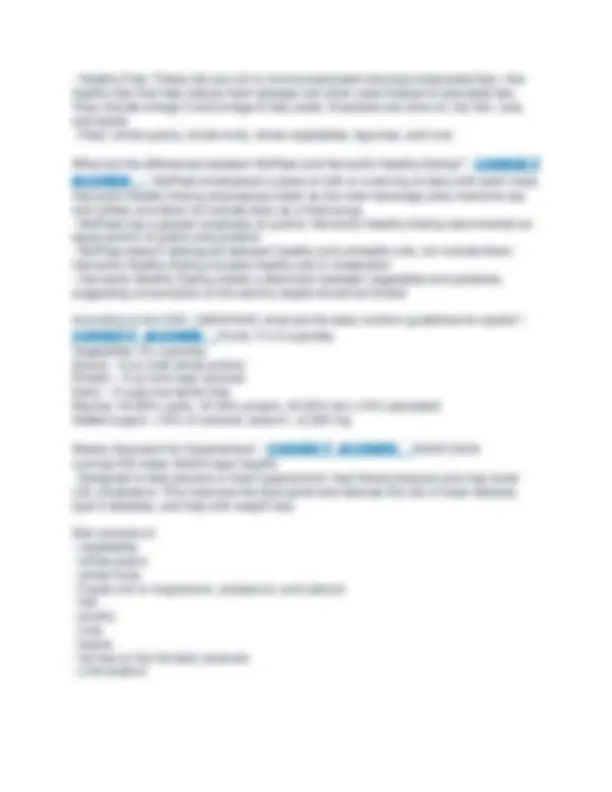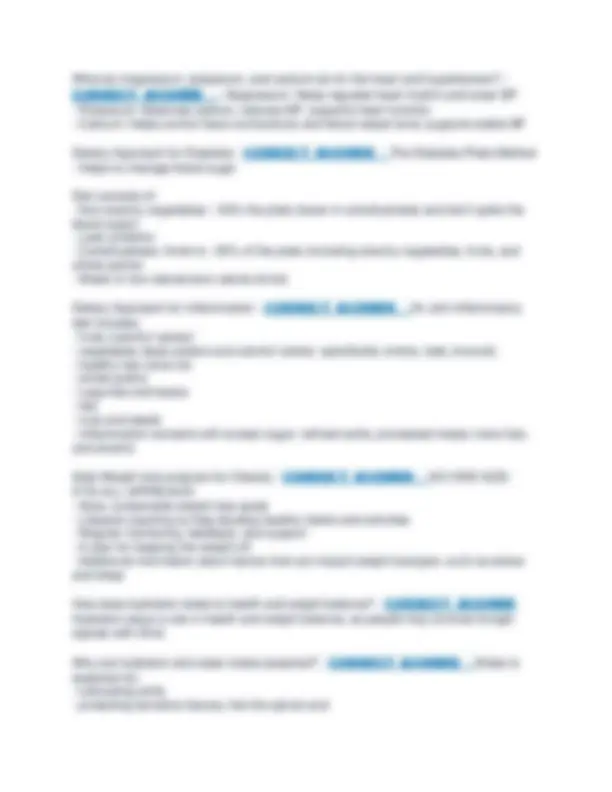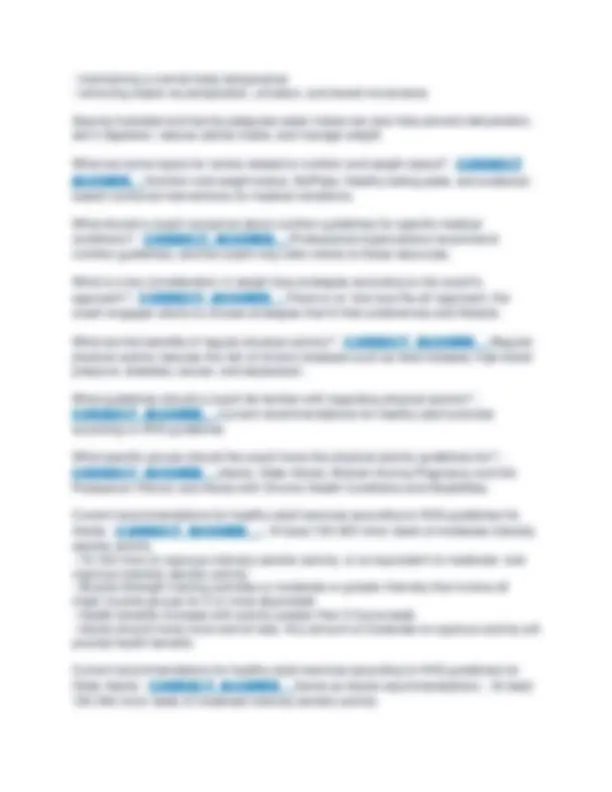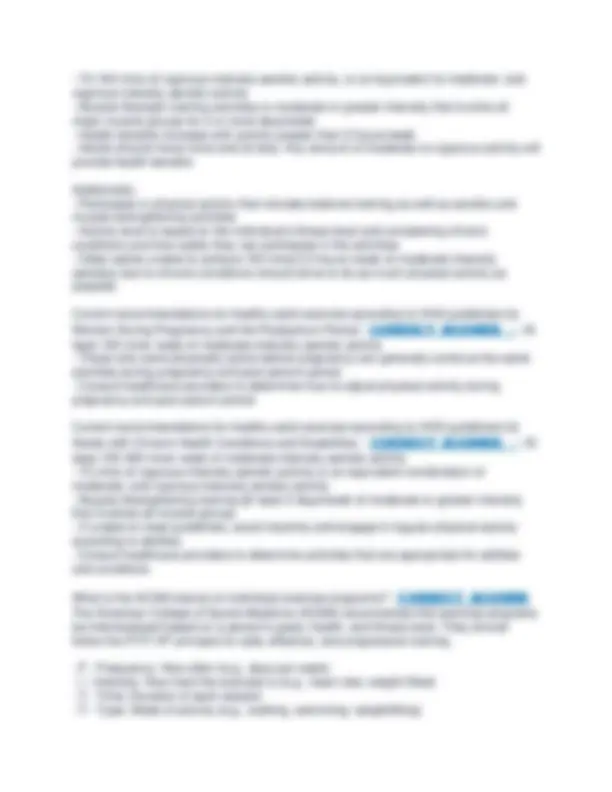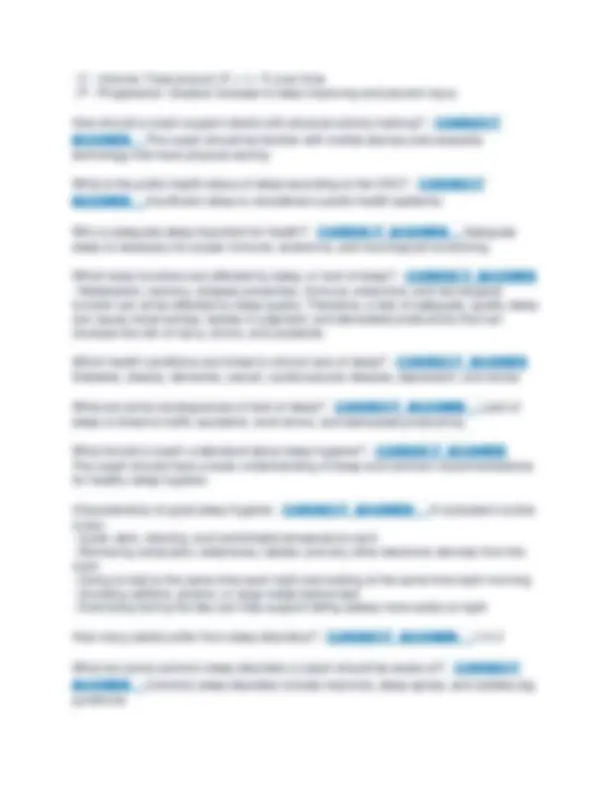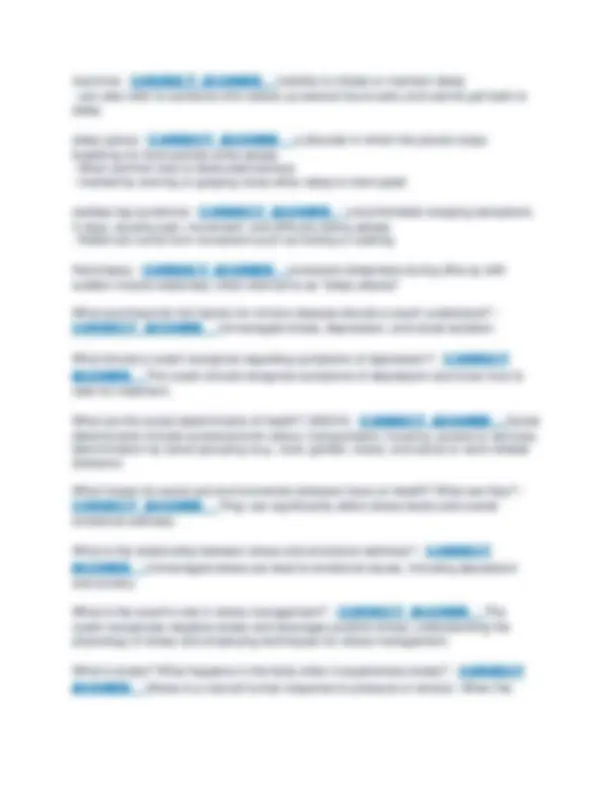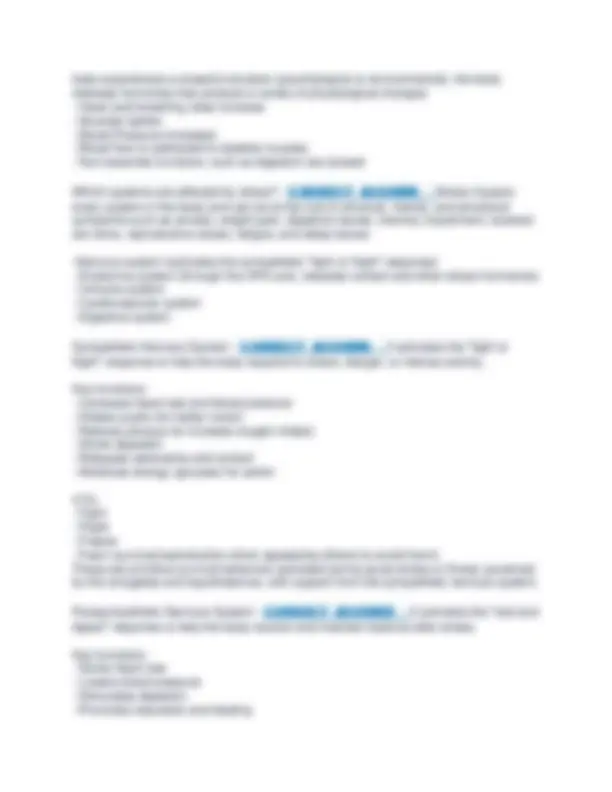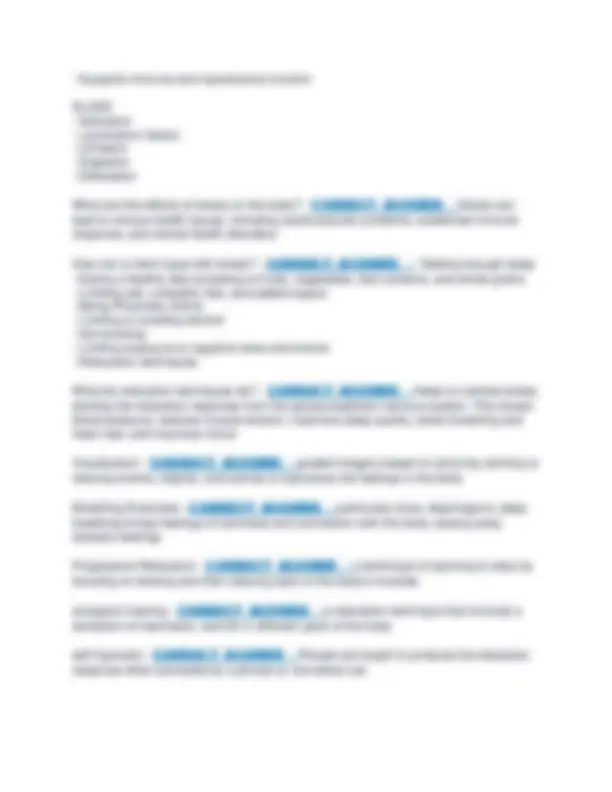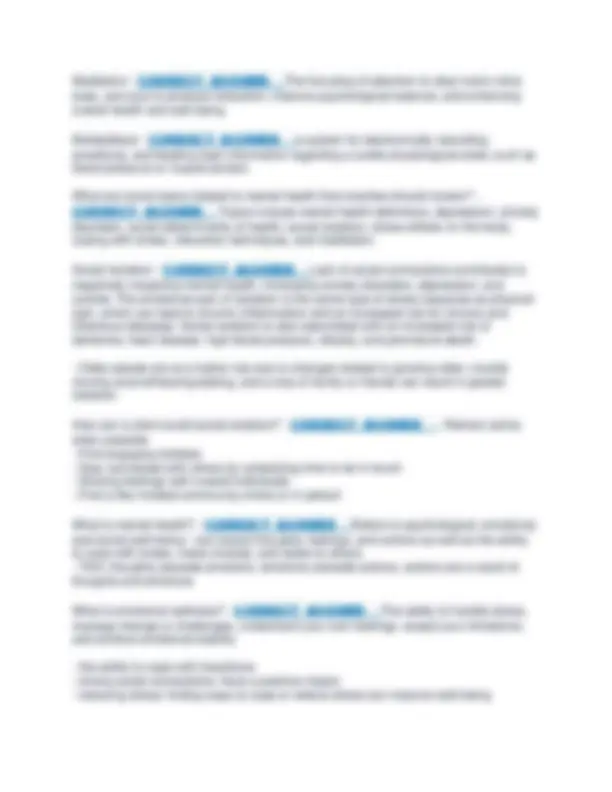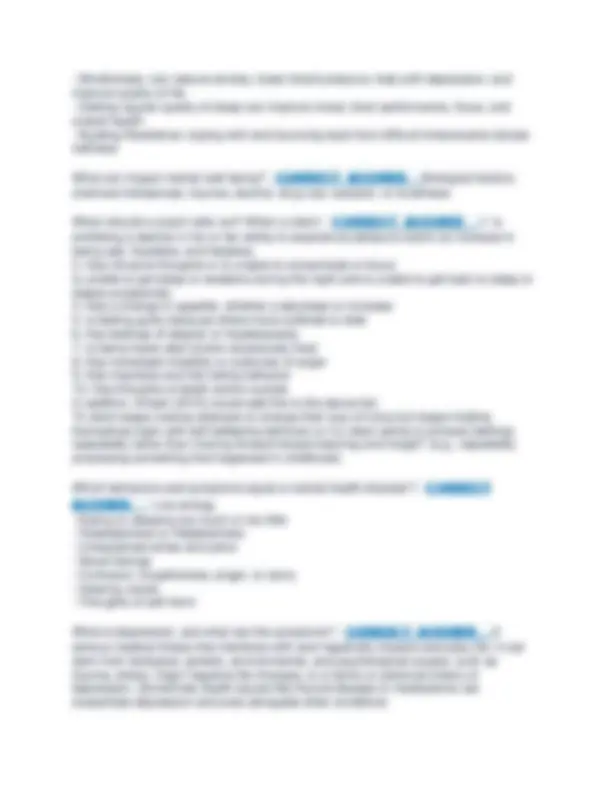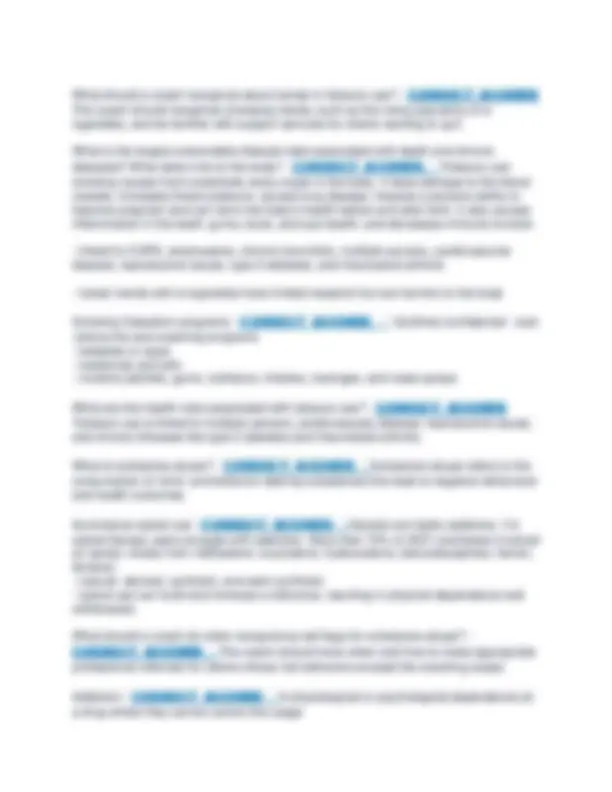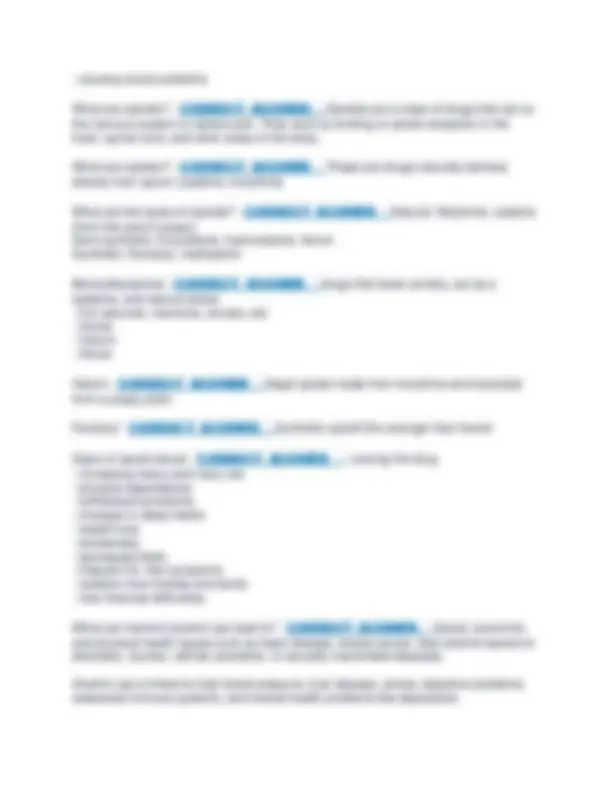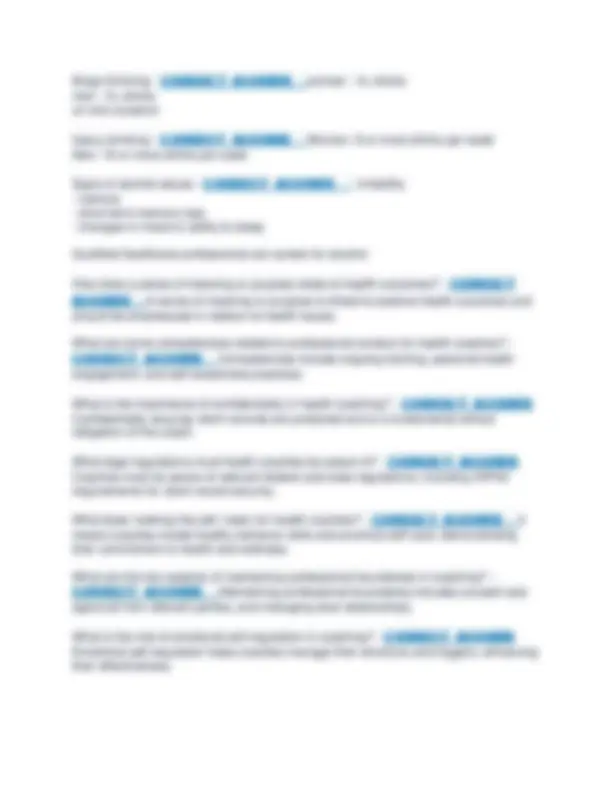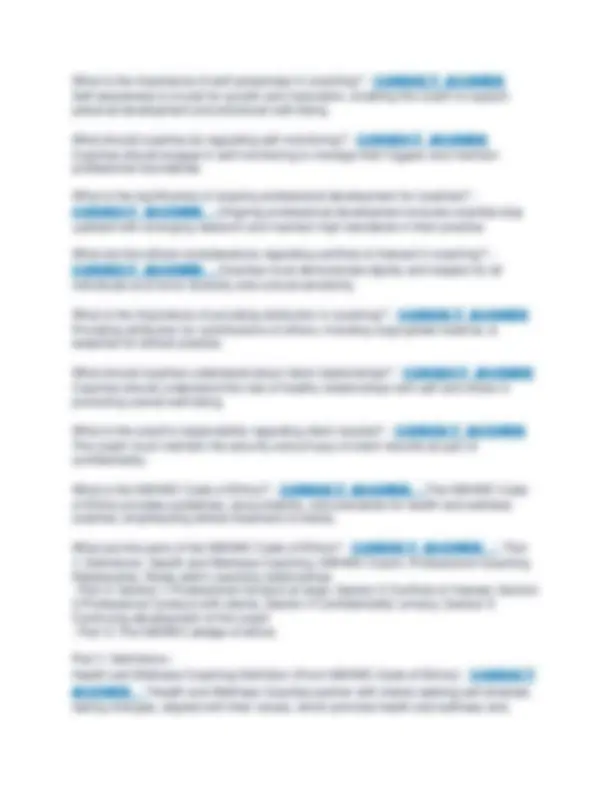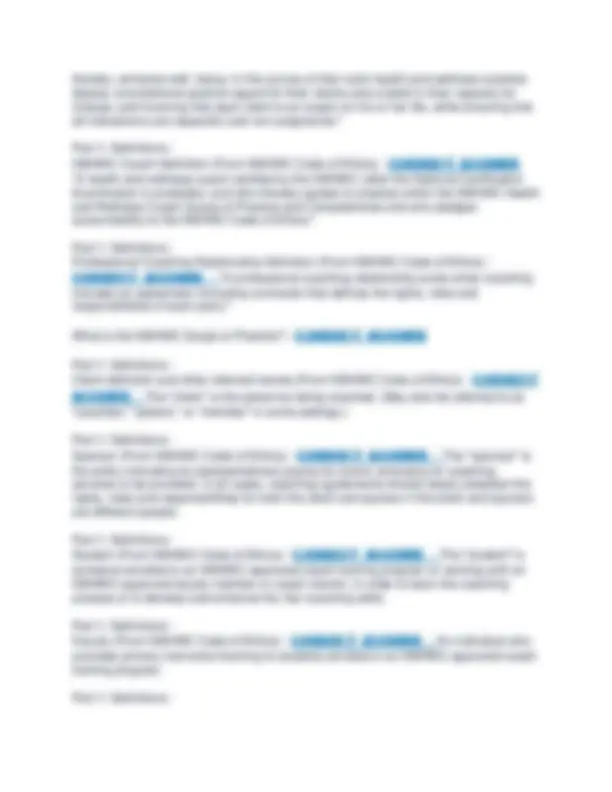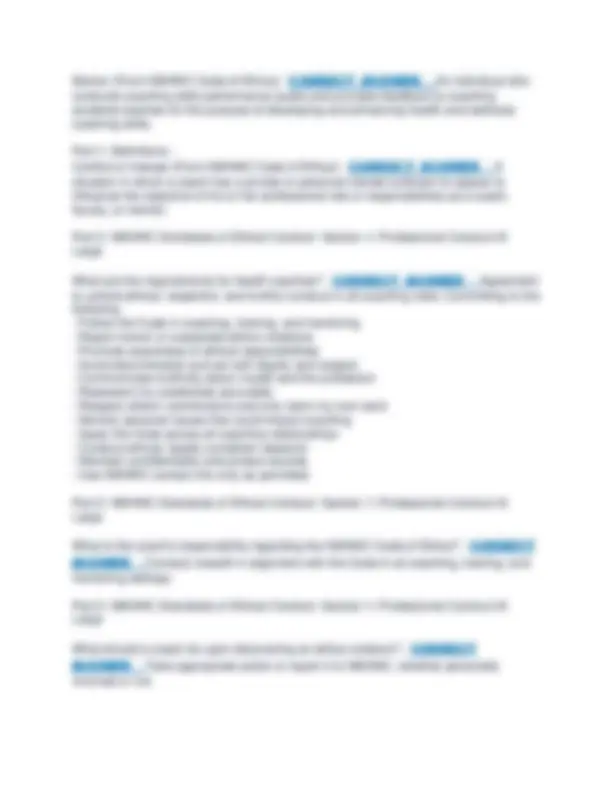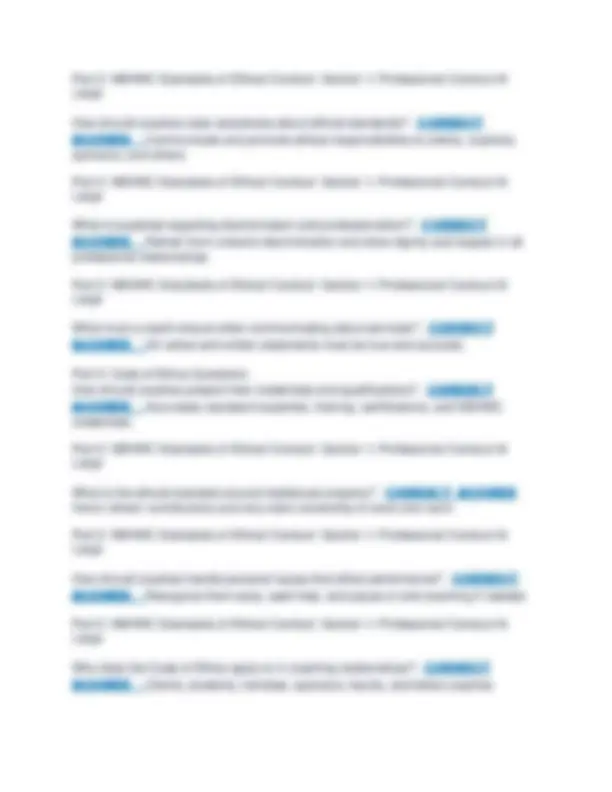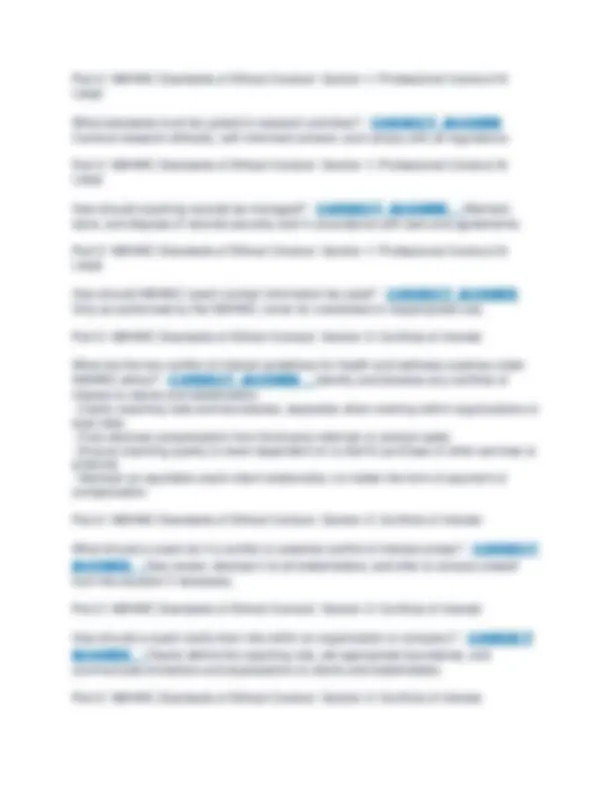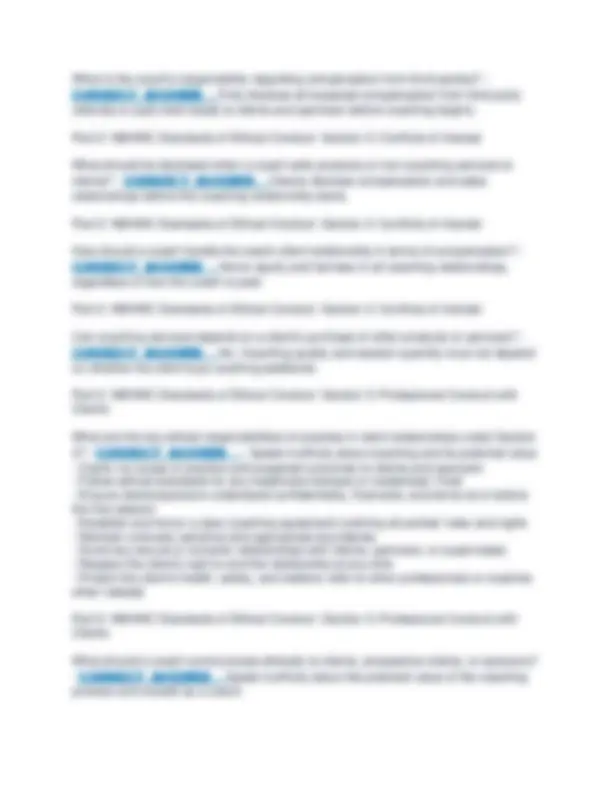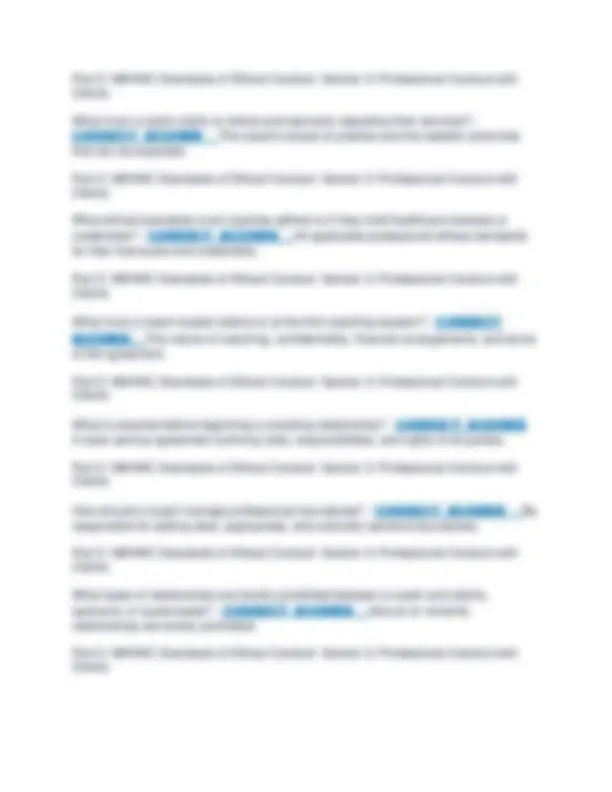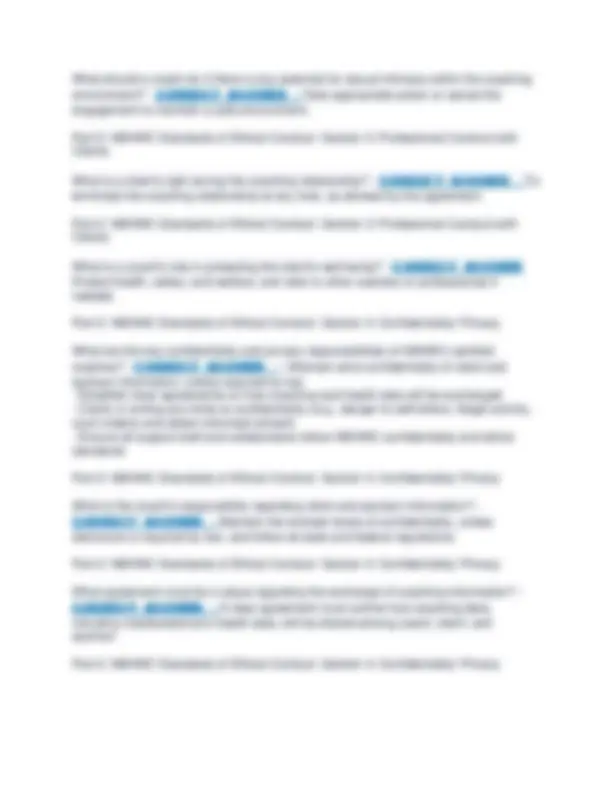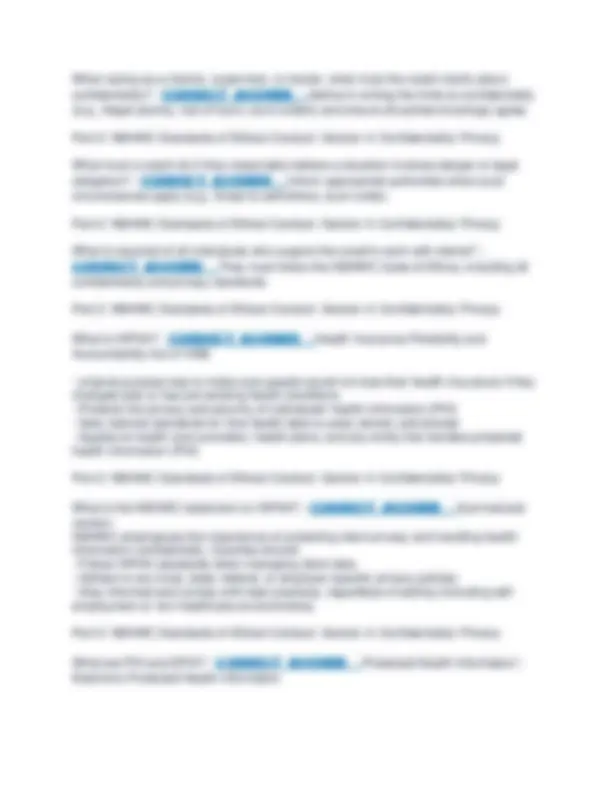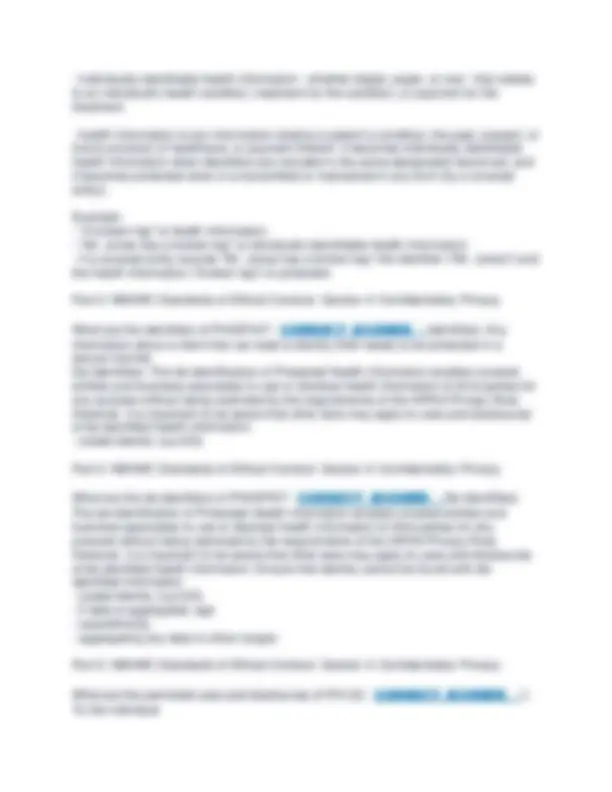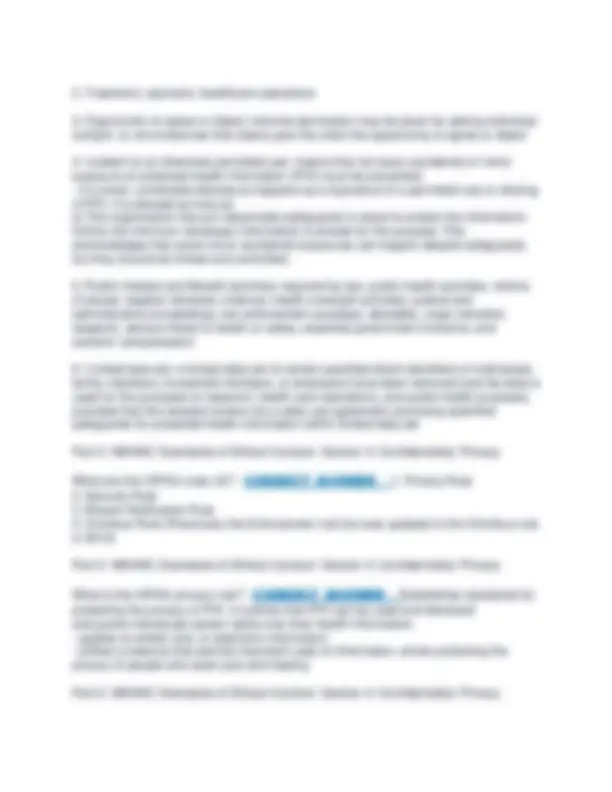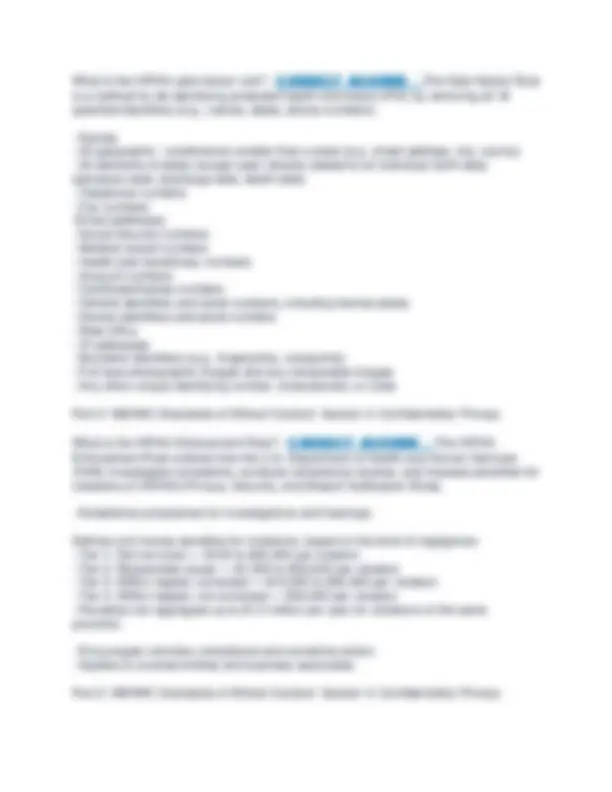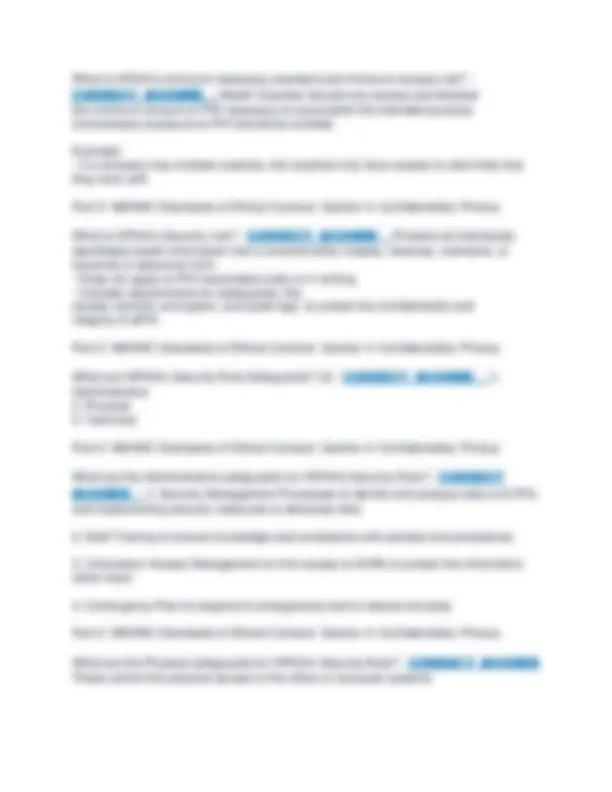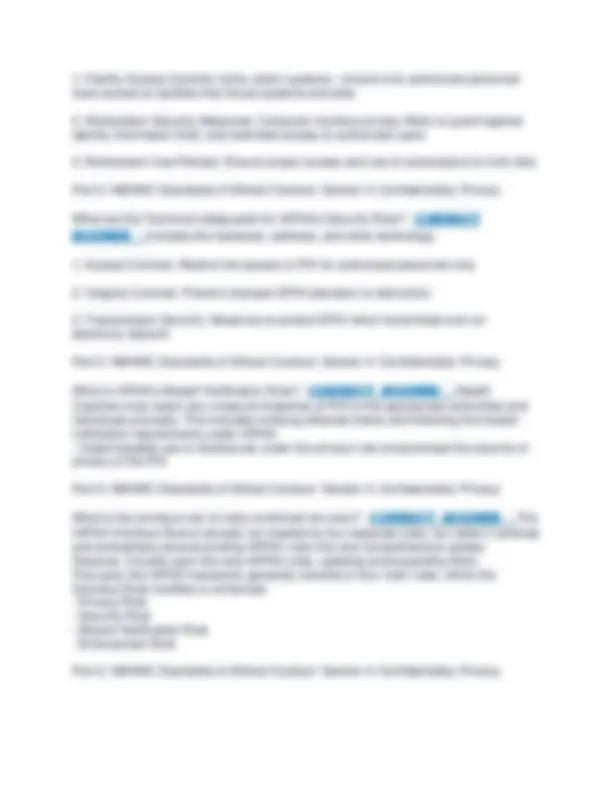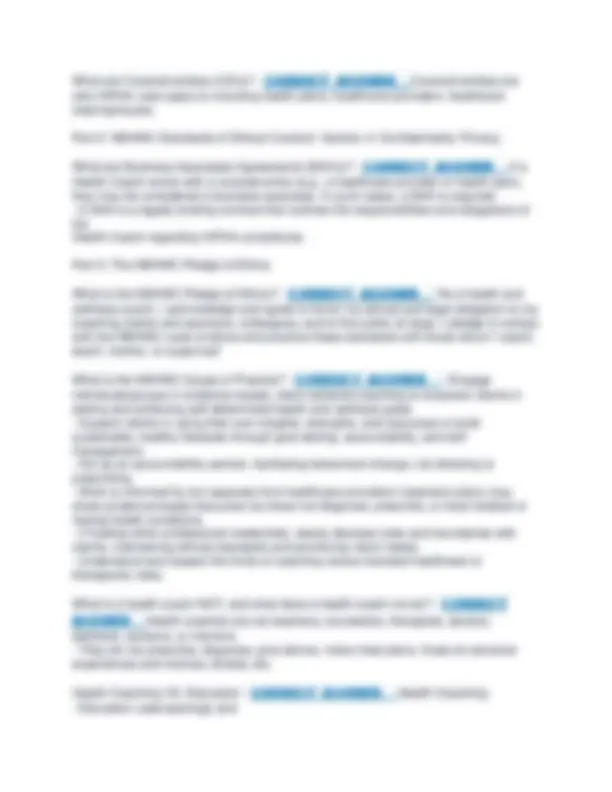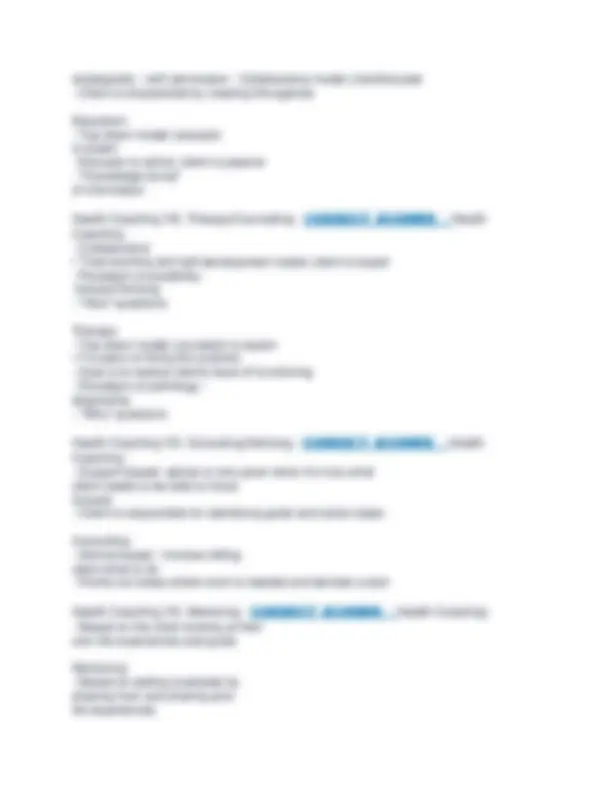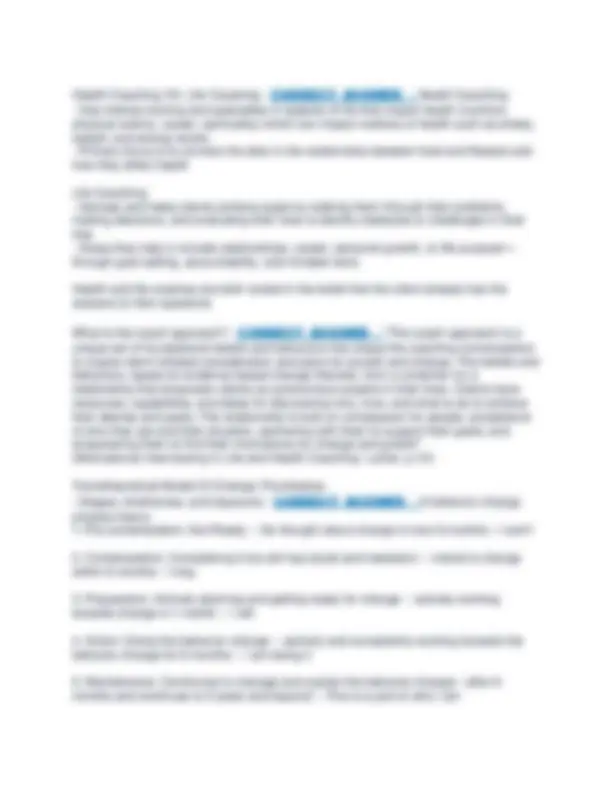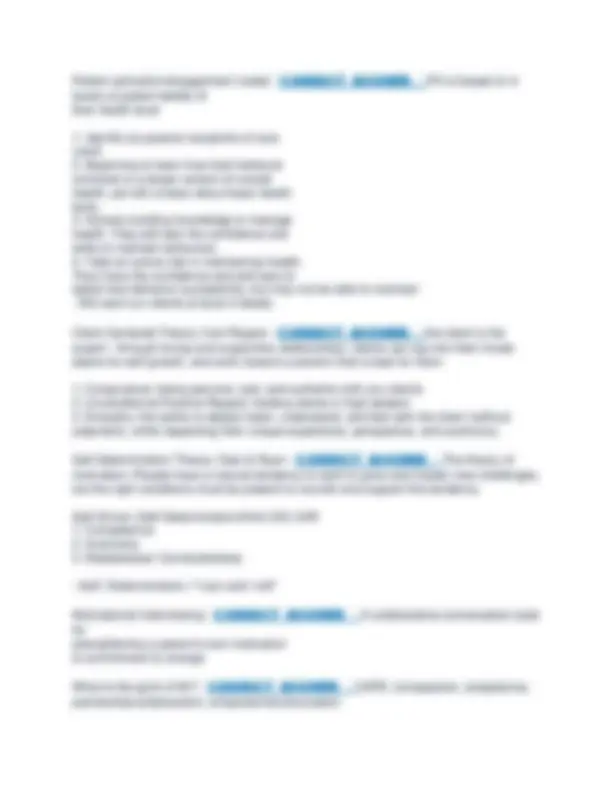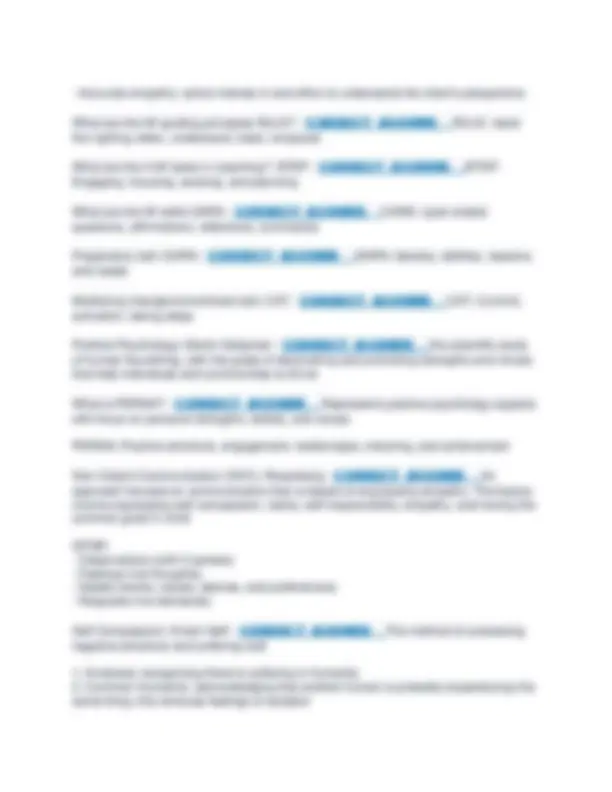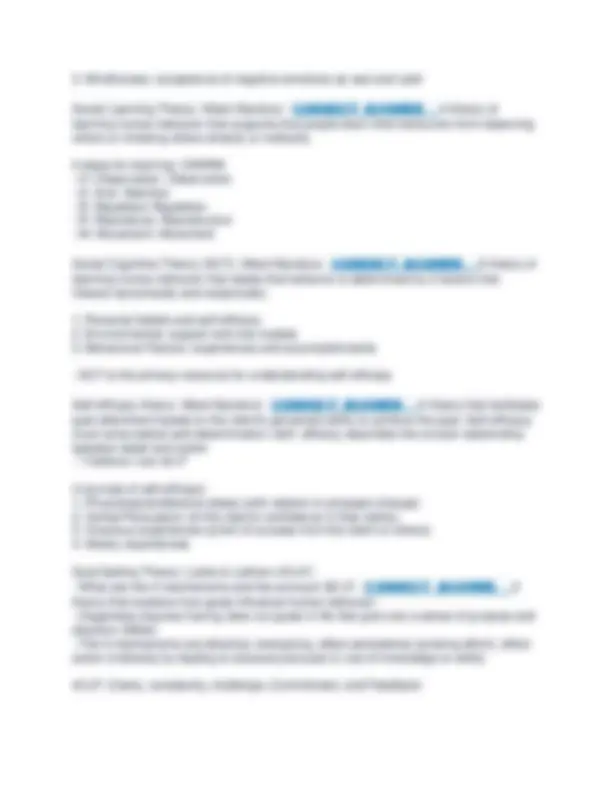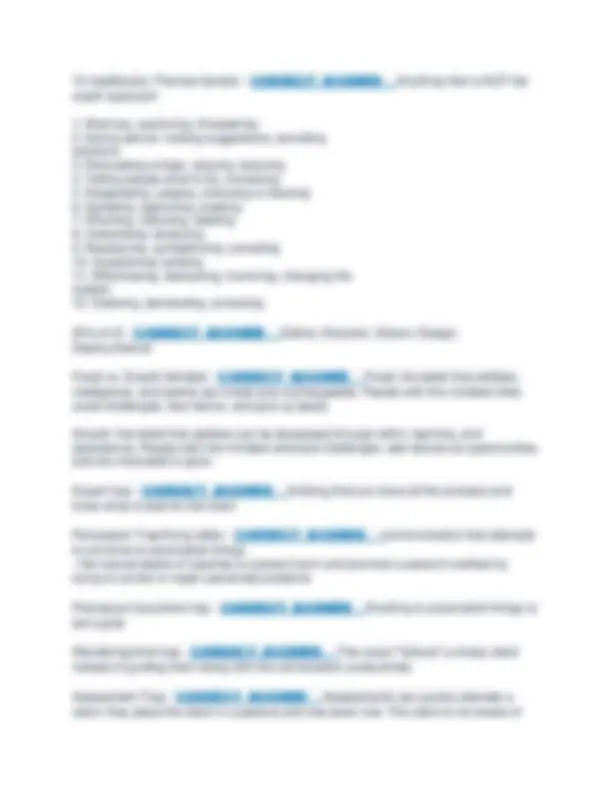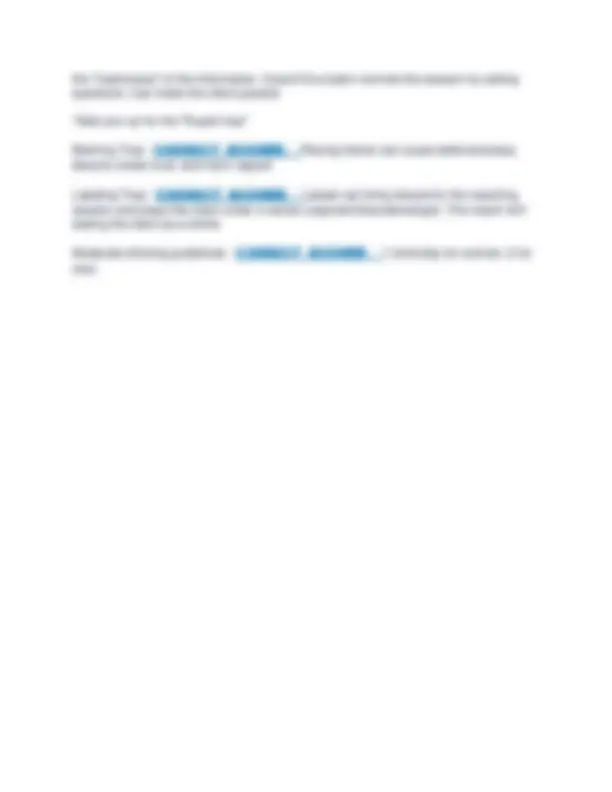Download NBHWC July 2025 Exam LATEST VERSION [ 421 QUESTIONS AND ANSWERS] WITH STUDY GUIDE DETAIL and more Exams Nursing in PDF only on Docsity!
NBHWC July 2025 Exam LATEST VERSION [ 421
QUESTIONS AND ANSWERS] WITH STUDY GUIDE
DETAILED AND VERIFIED FOR GUARANTEED PASS-
LATEST UPDATE 2025 GRADED A TESTBANK
What is the coach's role in determining the focus of coaching? - CORRECT ANSWER The coach empowers the client to select an area that feels important, motivating, timely, and client-directed What should a coach ensure regarding time management in sessions? - CORRECT ANSWER Ensure appropriate time management for this and all sessions.
- Respect the client and gently guide along back to the conversation if they get off track What is the significance of the coaching process overview? - CORRECT ANSWER It clarifies the expectations and responsibilities of both the coach and the client. What is the importance of establishing rapport in the first session? - CORRECT ANSWER It helps create a trusting relationship and sets a positive tone for coaching. What should a coach clarify about their role during the initial session? - CORRECT ANSWER That they will not diagnose or prescribe, nor give unsolicited advice. Examples of what the coach does and does not do, confidentiality, etc. What is the client's responsibility in the coaching relationship? - CORRECT ANSWER To self-determine their vision, goals, and action steps. What should be reviewed before determining if a client is suitable for coaching? - CORRECT ANSWER Information and assessments provided by the client.
- Assess client's intentions for coaching and their readiness What is the purpose of gauging the client's intentions for coaching? - CORRECT ANSWER To understand why coaching is sought and to align the coaching process with the client's needs. What is the expected outcome of the initial coaching session? - CORRECT ANSWER To confirm the coaching agreement and establish a clear understanding of roles and expectations.
How should the coach handle logistics for the coaching session? - CORRECT ANSWER Confirm meeting location, conference call arrangements, and other logistical details. What is the role of the coach in the client's self-discovery process? - CORRECT ANSWER To facilitate exploration and reflection, allowing the client to uncover their own insights. What is the first competency in assessing a client's health and wellbeing? - CORRECT ANSWER Have the client assess their current state of health and/or wellbeing. What should a coach explore regarding a client's health vision? - CORRECT ANSWER The client's vision of their optimal health and/or wellbeing. How can a coach identify gaps in a client's lifestyle? - CORRECT ANSWER By asking open-ended questions that get the client to reflect; the coach will listen for and allow the client to identify the gaps between their current state and their desired lifestyle/outcomes.co What is the purpose of establishing a client's long-term goals? - CORRECT ANSWER To lead toward desired outcomes. What does SMART stand for in goal setting? - CORRECT ANSWER Specific, Measurable, Achievable, Relevant, Time-bound. What is the role of a coach in supporting a client's SMART goals? - CORRECT ANSWER To support the client in achieving the SMART goals or action steps, including backup plans. What should a coach ask regarding the client's learning? - CORRECT ANSWER About the client's preferences and style of learning and maintaining accountability. What is the focus of routine ongoing coaching sessions? - CORRECT ANSWER To assess the client's current state, review previous action steps, and define new action steps. What should a coach do at the beginning of each session? - CORRECT ANSWER Connect with the client and have them self-assess their state. What is important to check-in on during routine coaching sessions? - CORRECT ANSWER Prior session commitments/action steps.
How does a coach's confidence in a client affect the client? - CORRECT ANSWER It supports the client's self-efficacy. What is one way a coach builds trust with a client? - CORRECT ANSWER By attending to the client's emotions as well as their words and behaviors.
- Active listening, mirroring, empathy, compassion, mindfulness, reflections, and summaries to show the coach is present and paying attention What should a coach do when they sense conflict or discomfort in a client? - CORRECT ANSWER Acknowledge what is happening with curious interest. What are the key competencies related to trust and support in coaching? - CORRECT ANSWER 1. Demonstrate benevolence, honesty, sincerity, and authenticity. 2. Convey unconditional positive regard. 3. Follow through on commitments. 4. Address discord/conflict openly and resolve it timely. What does active listening involve beyond verbal communication? - CORRECT ANSWER It includes being attuned to nonverbal cues such as expression, tone, emotions, and energy. What is the purpose of using silence in coaching? - CORRECT ANSWER To hold the space for clients, allowing them time to reflect, process, and identify what emerges.
- WAIT (Why Am I Talking?) What are some competencies related to active listening? - CORRECT ANSWER
- Be attentive and mindful. 2. Be open-minded. 3. Be curious without assumptions. 4. Pace communication to fit client's needs. 5. Listen for what is not being said. 6. Use silence appropriately. How can emotions impact a client's learning and change process? - CORRECT ANSWER Emotions can generate insight and affect the brain's capacity for learning and change. What role does self-compassion play in coaching? - CORRECT ANSWER It allows for a more honest appraisal of behaviors and promotes better self-care. What should a coach do to support a client's emotional state? - CORRECT ANSWER Attend to the client's state of being, acknowledge their emotions, and foster self- compassion. What is the purpose of reflections in coaching? - CORRECT ANSWER Reflections convey active listening and provide clients the opportunity to witness their own words and beliefs.
What types of reflections can a coach use? - CORRECT ANSWER 1. Simple reflections:
- Double-sided reflections
- Amplified reflections
- Summaries How can a coach help expand a client's thinking? - CORRECT ANSWER By asking curious, open-ended questions that encourage exploration and self-reflection. What types of questions should a coach use to evoke deeper thinking? - CORRECT ANSWER Open-ended questions that start with 'what' or 'how'. What is the significance of acknowledging a client's emotions? - CORRECT ANSWER It helps the client feel understood and supported, fostering a better coaching relationship. What does 'nonjudgmental reflections' mean in coaching? - CORRECT ANSWER Engaging the client without judgment to inspire learning and awareness. What is a double-sided reflection? - CORRECT ANSWER A reflection that highlights a discrepancy in the client's words, emotions, or behavior. What is an amplified reflection? - CORRECT ANSWER A reflection that exaggerates the client's statements to encourage reconsideration of resistance. Why is it important for a coach to notice nonverbal communication? - CORRECT ANSWER It provides insights into the client's true feelings and states that may not be verbally expressed. What is the overall goal of expanding the conversation in coaching? - CORRECT ANSWER To help clients explore strengths, values, and opportunities for learning. How should a coach manage their own feelings during a session? - CORRECT ANSWER Through mindful awareness and self-management to avoid imposing their own needs on the client. What are open-ended questions used for in coaching? - CORRECT ANSWER To facilitate exploratory thinking and encourage deeper client engagement.
- Ask 1 question for every 2 reflections
What does SMART stand for in goal-setting? - CORRECT ANSWER Specific, Measurable, Achievable/Attainable, Realistic/Relevant, Timely. What is the difference between behavioral goals and outcome goals? - CORRECT ANSWER Behavioral goals focus on the process and learning, while outcome goals focus on the final results. How should a coach approach client progress reviews? - CORRECT ANSWER By emphasizing the client's effort and learning rather than solely focusing on outcomes. What is the purpose of positive reframing in coaching? - CORRECT ANSWER To shift client perspectives to a more positive view, enhancing motivation and progress. What is the significance of behavior tracking in coaching? - CORRECT ANSWER To help clients monitor their actions and progress toward their goals. What does an accountability plan involve in the coaching process? - CORRECT ANSWER Developing a structured approach for clients to take responsibility for their actions and commitments. Why is it important to anticipate and plan for challenges in coaching? - CORRECT ANSWER To help clients navigate obstacles effectively and maintain progress toward their goals. What is the role of visualizing in the coaching process? - CORRECT ANSWER To elicit intrinsic motivation and clarify goal direction for the client. How does a coach facilitate perspective shifts for clients? - CORRECT ANSWER By reflecting the client's views and asking open-ended questions to enhance self- awareness. What is the importance of client engagement models in coaching? - CORRECT ANSWER To support clients in becoming active participants in their own health and wellness journey. What is the goal of incorporating various dimensions of a client's life in coaching? - CORRECT ANSWER To create a holistic understanding of the client's experiences and challenges.
- Multidimensional Health What is the role of self-talk in coaching? - CORRECT ANSWER The coach listens for the client's self-talk and helps them consider more positive self-talk.
- How one speaks to and about oneself may be revealed in behaviors
What are the competencies related to reframing in coaching? - CORRECT ANSWER Reframe, address self-defeating perceptions, explore patterns related to client behaviors and decision tendencies, and awareness of self-talk. What is the focus of coaching psychology regarding client motivation? - CORRECT ANSWER Coaching psychology focuses on eliciting the client's intrinsic motivation based on their purpose, meaning, values, and preferences. What are the competencies involved in eliciting a client's perspectives? - CORRECT ANSWER Elicit reasons for change, solutions, ideas, experiments, desires, reactions, desired outcomes, and rewards/incentives. What does self-determination theory emphasize in coaching? - CORRECT ANSWER It posits universal needs for psychological health: autonomy, competence, and relatedness. How does a coach help develop a client's self-efficacy? - CORRECT ANSWER By helping the client understand their needs, gain self-awareness, learn from setbacks, develop resources, and navigate their environment. What competencies are involved in improving self-efficacy? - CORRECT ANSWER Explore ways to improve self-efficacy, engage in problem-solving, evaluate options, and use awareness and tools to support informed decisions. What is the significance of social cognitive theory in coaching? - CORRECT ANSWER It includes concepts from Social Learning Theory and Self-Efficacy Theory, emphasizing role models and mastery. What is the coach's role in improving client support systems? - CORRECT ANSWER The coach assists clients in developing supportive relationships and identifying community resources for ongoing success. What competencies are related to improving support? - CORRECT ANSWER Social support and structural/environmental support. What is the importance of active experimentation in coaching? - CORRECT ANSWER It allows clients to feel safe to experiment with new ideas and behaviors, fostering a growth mindset. What does a growth mindset entail in coaching? - CORRECT ANSWER The belief that a client's abilities are not fixed and can be improved through experimentation and persistent efforts.
How can positive psychological resources be increased? - CORRECT ANSWER By identifying, exploring, cultivating, and affirming skills, efforts, strengths, values, positive emotions, optimism, and resilience. What is the primary role of health and wellness coaches regarding health or disease? - CORRECT ANSWER They are not content experts and do not diagnose or prescribe unless they have credentials allowing it. What should health and wellness coaches be familiar with? - CORRECT ANSWER Current evidence-based recommendations from public health groups like the CDC and NIH. What areas do relevant health guidelines and recommendations cover? - CORRECT ANSWER Health promotion, disease prevention, and lifestyle medicine. What is an important focus for health and wellness coaches? - CORRECT ANSWER Recognizing potential imminent danger and medical red flags, and knowing when to refer clients to healthcare professionals. Why is it important for coaches to stay updated on health guidelines? - CORRECT ANSWER Recommendations change frequently and vary by organization, impacting client choices and resources. What is the coaching relationship primarily centered on? - CORRECT ANSWER Determining what the client already knows, needs, and wishes to learn. What general knowledge is required for health and wellness coaches? - CORRECT ANSWER Knowledge about healthy living to facilitate various competencies in coaching conversations. What is a valuable resource for coaches and clients provided by the CDC? - CORRECT ANSWER A robust, evidence-based website with useful health information. What is Healthy People 2020? - CORRECT ANSWER A program of nationwide health-promotion and disease-prevention goals set by the U.S. Department of Health and Human Services. What does wellness encompass beyond the absence of disease? - CORRECT ANSWER All aspects of physical, psychological, spiritual, and social well-being. What perspective do many coach training programs emphasize? - CORRECT ANSWER A whole-person perspective using frameworks like a wellness wheel.
What are the key topics for review regarding wellness and well-being concepts? - CORRECT ANSWER Health-related quality of life, well-being concepts, and the Travis Illness-Wellness Continuum. What is the Travis Illness-wellness continuum? - CORRECT ANSWER Wellness is not merely the absence of disease, but extends beyond into awareness, education, and growth. The continuum goes from premature death to high-level wellness. Individuals can travel along the continuum throughout life. Neutral point would be the absence of disease without further growth What is HRQOL and well-being - CORRECT ANSWER Health-related quality of life: A multidimensional measure of how physical, mental, emotional, and social well- being affect a person's overall quality of life.
- CDC: Focuses on self-rated health and "healthy days."
- NIH: Uses PROMIS (patient-reported outcomes measurement information systems) to measure patient-reported outcomes across health domains. Well-Being (CDC & NIH) A holistic concept including physical, mental, emotional, and social health.
- CDC: Public health outcomes tied to life satisfaction, functioning, and resilience.
- NIH: Patient-centered measurement of health domains via PROMIS. What competencies should coaches have regarding chronic disease? - CORRECT ANSWER Enhancing client self-management, identifying risk factors, understanding measurement standards, and recognizing medical red flags. Who do coaches often work with regarding chronic medical conditions? - CORRECT ANSWER Clients living with chronic conditions and those at risk due to unhealthy behaviors. What is the definition of wellness as a concept? - CORRECT ANSWER A self- directed and evolving process to achieve full potential across multiple dimensions. What is the significance of positive emotions in positive psychology? - CORRECT ANSWER They contribute to resilience, optimism, and overall well-being. What should coaches be able to identify regarding chronic disease? - CORRECT ANSWER Risk factors and commonly used biometric measures. What is the role of gratitude and acceptance in positive psychology? - CORRECT ANSWER They are part of the positive emotions that enhance psychological resources.
- Headaches, shortness of breath, nosebleeds, and flushing. What is the significance of measuring blood pressure? - CORRECT ANSWER It helps in diagnosing hypertension and monitoring treatment effectiveness. What are some risk factors for hypertension? - CORRECT ANSWER - Medical conditions such as obesity or diabetes
- Behavioral/lifestyle choices such as physical inactivity, alcohol and tobacco use, or unhealthy eating habits
- Family history or genetics: genes and common shared environments as well as age, sex (women can develop it during pregnancy), and ethnicity How can blood pressure be controlled? - CORRECT ANSWER High blood pressure can be managed or prevented with healthy lifestyle changes:
- Increased physical activity: @ least 150 min of moderate physical activity/week for adults w/ 2 days of muscle strengthening activities
- Improve diet and limit sodium and alcohol intake
- Managing stress
- Not Smoking
- In some cases, using blood pressure medication as prescribed by a medical doctor Why should someone lower their sodium intake if they have high blood pressure? - CORRECT ANSWER Sodium helps to balance fluids in the body and plays a role in how the muscles/nerves work; the kidneys balance the amount of sodium in the body
- Sodium attracts and holds on to H20. Too much sodium results in an increase in the blood volume, directly causing the heart to work harder to pump, and increasing the blood pressure in the arteries What should be reviewed regarding diabetes? - CORRECT ANSWER About diabetes, who's at risk, symptoms, prediabetes, type 2 diabetes, and getting tested. What is diabetes? How does it affect the body? - CORRECT ANSWER Diabetes is a chronic disease that occurs when the pancreas does not produce enough insulin (a hormone that regulates blood glucose) or the body cannot effectively use the insulin it produces, impacting how the body turns food into energy
- The body typically breaks down the food you eat into glucose/sugar and releases it into the bloodstream. As blood sugar increases, the pancreas releases insulin.
- Diabetes prevents the body from making enough insulin or using it as well as it should, resulting in too much blood sugar staying in the bloodstream, leading to health problems over time, such as vision loss, heart or kidney disease How can diabetes be prevented or managed? - CORRECT ANSWER - Type 1: No prevention or cure. Requires daily administration of insulin. Diet and lifestyle adjustments can help prevent complications
- Type 2: Can be prevented with lifestyle and dietary adjustments
- Gestational: lifestyle and dietary adjustments
- Pre-diabetes: Lifestyle and dietary adjustments
- Lifestyle and dietary adjustments include: losing weight or maintaining a healthy weight, eating a healthy diet, getting regular physical activity, stress management, no tobacco use/smoking, and limit alcohol consumption What are typical diabetes symptoms? - CORRECT ANSWER - Urinating frequently, often at night
- Being very hungry or thirsty
- Having blurry vision or numb or tingling hands or feet
- Losing weight without trying
- Feeling extra tired
- Having very dry skin
- Having more infections or sores that heal slowly
- Gestational diabetes does not have symptoms, and pre-diabetes frequently remains undetected for a long-time until a more serious health issue arises (such as type 2 diabetes) What are the differences between the types of diabetes (T1, T2, Gestational, and Pre- diabetes)? Who is at risk for each type? - CORRECT ANSWER - Type 1: is a chronic condition believed to be caused by an autoimmune reaction that results in the body making little to no insulin. This is typically found in children, teens, and young adults, but may also develop in adults.
- Type 2: Develops over time and is the result of an issue with the way that the body regulates and uses sugar. The pancreas doesn't produce enough insulin, and cells respond poorly to the available insulin, taking in less sugar and resulting in too much sugar in the bloodstream. Type 2 diabetes is most common in adults, but children, especially those with obesity, can develop it.
- Gestational: Develops in women during their first pregnancies or those who've never previously had diabetes. This type can increase the risk of type 2 diabetes for the mother and can affect the baby's health, increasing its risk for childhood or teen obesity and Type 2 diabetes in the future. There are typically no symptoms for Gestational Diabetes.
- Pre-Diabetes: when the blood sugar is higher than normal, but not high enough to be type 2 diabetes. This can raise the risk for stroke, heart disease, and type 2 diabetes. Anyone is at risk with risk factors of obesity and physical inactivity. What are the risk factors for T2, Gestational, and Pre-diabetes? - CORRECT ANSWER - Type 2: being overweight, having a parent or sibling with type 2 diabetes, being over 45 years old, having had gestational diabetes or giving birth to a
- Normal: 139 mg/dl
- Pre-Diabetes: 140-199 mg/dl
- Diabetes: 200 mg/dl or above What are the typical blood sugar targets before a meal and 2 hours after eating? - CORRECT ANSWER - Before: 80-130 mg/dl
- 2 Hours After: greater than 180 mg/dl What are the key topics for understanding obesity? - CORRECT ANSWER Obesity causes and consequences, assessing Body Mass Index (BMI) and waist circumference, and abdominal obesity. What is the relationship between obesity and health? - CORRECT ANSWER Obesity is linked to various health issues, including diabetes and cardiovascular disease. What are the causes and consequences of obesity? - CORRECT ANSWER Obesity is caused by a combination of:
- Behavioral factors - poor diet, physical inactivity, lack of sleep
- Environmental factors - limited access to healthy food, safe spaces to exercise
- Genetic and biological factors - metabolism, family history, hormonal conditions
- Psychosocial factors - stress, trauma, emotional eating, socioeconomic status
- Medications - some antidepressants, antipsychotics, steroids, and insulin
- Consequences: Increased risk of heart disease, type 2 diabetes, some cancers, joint problems, sleep apnea, and reduced quality of life. What is BMI, and what are the ranges for underweight, normal, overweight, and obesity classes I-III? - CORRECT ANSWER Body Mass Index is used to estimate weight status about a potential disease risk. BMI is a measurement of body fat based on a person's height and weight. Not a perfect measure of health because it does not take into account fat vs. muscle mass, body composition, ethnicity body composition, age, and sex differences. However, it can help assess overall health and identify potential risks associated with weight
- Underweight: less than 18.
- Normal: 18.5-24.
- Overweight: 25.0-29.
- Obesity Class I: 3 0 - 34.
- Obestiy Class II: 35- 39.
- Extreme Obesity Class III: greater than or equal to 40 What is waist circumference? What are the ranges for men and women? - CORRECT ANSWER Waist circumference is used to measure body weight, specifically fat
distribution in the abdominal area. Excessive abdominal fat can indicate a greater risk of obesity-related conditions such as type 2 diabetes, high blood pressure, and coronary artery disease
- Normal: (M) 37 in. and below; (F) 31.5 in. and below
- Intermediate Risk: (M) 37.1- 39.9 in.; (F) 31.6- 34.9 in.
- High Risk: (M) 40 in. and above; (F) 35 in. and above What is the waist-to-hip ratio? - CORRECT ANSWER The measurement of the waist/hip in inches. expressed as a ratio. The risk of stroke increases once the measurement is above the following:
- Non-pregnant women: 0.85/ 85%
- Men: 0.95/ 95% Why is excessive abdominal fat problematic? What can it be linked to? - CORRECT ANSWER Carrying excessive weight puts a strain on the body and can increase the risk to health, including weakened immune function. Excessive abdominal fat, or visceral fat, wraps around internal organs and releases inflammatory substances and hormones that disrupt metabolism and insulin sensitivity. Excess abdominal fat is linked to:
- Heart disease
- Type 2 diabetes
- Insulin resistance
- High blood pressure
- High cholesterol and triglycerides
- Stroke
- Certain cancers (e.g., colorectal, breast)
- Fatty liver disease
- Inflammation and metabolic syndrome What are the main topics for cardiovascular disease? - CORRECT ANSWER Heart disease basics, heart attack signs and symptoms, and risk factors including medical conditions, behavior, and family history. What is cardiovascular disease (CVD)? - CORRECT ANSWER Refers to a group of conditions related to disorders of the heart and blood vessels--- the #1 leading cause of death and disability around the world
- two of the most common conditions of CVD are Coronary Artery Disease and Stroke What is coronary artery disease (CAD)? What are the signs/symptoms? - CORRECT ANSWER CAD, also called ischemic heart disease or coronary heart disease, is caused by a buildup of plaque (a combination of cholesterol, fat, calcium, and other
- Some may need medications What does cholesterol do in the blood? - CORRECT ANSWER Cholesterol is a lipid found in all cells of the body and is used to build cell membranes, create hormones, make vitamin D, and form bile acids that aid digestion of fats
- The body makes all the cholesterol it needs, so we do not need to get it through food
- LDL "bad" cholesterol---- Carries cholesterol to arteries, can build up as plaque. Increases the risk of heart disease and stroke
- HDL"Good" cholesterol----Carries cholesterol away from arteries back to the liver for removal. Protects against heart disease What does calcium do in the blood? - CORRECT ANSWER Calcium in the blood is essential for:
- Muscle contraction (including the heart)
- Blood clotting (helps form clots to stop bleeding)
- Nerve signal transmission
- Maintaining healthy bone structure (balances calcium levels with bones)
- Regulating enzyme activity and hormone secretion
- Too much calcium/Hypercalcemia: Fatigue, muscle weakness, kidney stones, confusion, irregular heartbeat
- Too little calcium/Hypocalcemia: Muscle cramps/spasms, tingling, numbness, seizures, cardiac arrhythmias What do triglycerides do in the blood? - CORRECT ANSWER Triglycerides are a type of fat that:
- Store energy for later use
- Provide insulation and protect organs
- Help transport and absorb fat-soluble vitamins (A, D, E, K)
- Excess triglycerides can contribute to plaque buildup in arteries, increasing heart disease risk What does the lipid panel makeup measure? - CORRECT ANSWER - Triglycerides - The primary form of stored fat; used for energy
- Total Cholesterol - Waxy fat used for cell membranes and hormone production
- Low-Density Lipoprotein (LDL) - "Bad" cholesterol that can build up in arteries
- High-Density Lipoprotein (HDL) - "Good" cholesterol that removes excess cholesterol from arteries Optimal Lipid Panel Levels - CORRECT ANSWER - Total cholesterol: about 150 mg/dl
- LDL: about 100 mg/dl
- HDL: (m) about 40 mg/dl; (f) about 50 mg/dl
- Triglycerides: less than 150 mg/dl
What is the significance of understanding lipid panels? - CORRECT ANSWER They help assess cholesterol levels and cardiovascular risk. What are LDL and HDL cholesterol? What are optimal levels for men and women? - CORRECT ANSWER LDL is low-density lipoprotein (bad cholesterol), and HDL is high-density lipoprotein (good cholesterol). LDL: about 100 mg/dL HDL: (m) at least 40 mg/dL; (f) at least 50 mg/dL Risk factors for high cholesterol - CORRECT ANSWER - obesity
- type 2 diabetes
- not enough physical activity
- a diet high in trans fats and saturated fats
- age
- sex (women tend to have lower LDL lebels than men until menopause or age 55; men tend to have lower HDL levels than women) How to prevent and treat high cholesterol? - CORRECT ANSWER There is no need to obtain cholesterol from food because the body makes all it needs. Limit foods high in saturated fats and include foods high in fiber and low in trans and saturated fats, sodium, and added sugars may help prevent high cholesterol
- Maintain a healthy body weight
- Quitting smoking
- Limiting alcohol
- Staying physically active
- In some cases, medications can help lower LDL levels, such as statins, niacin, and injectable medications What should be reviewed about stroke? - CORRECT ANSWER Stroke basics, signs and symptoms, and risk factors including medical conditions, behavior, and family history. What is a stroke and what happens during one? - CORRECT ANSWER Two types of stroke
- Ischemic Stroke: Occurs when blood clots, plaque, or other particles block blood vessels to the brain
- Hemorrhagic Stroke: Occurs when an artery in the brain ruptures or leaks blood, putting too much pressure on brain cells and damaging them.
- When blood flow to the brain is blocked, brain cells can begin to die in minutes and parts of the brain can be damaged, resulting in long-term disability, brain damage, or death

